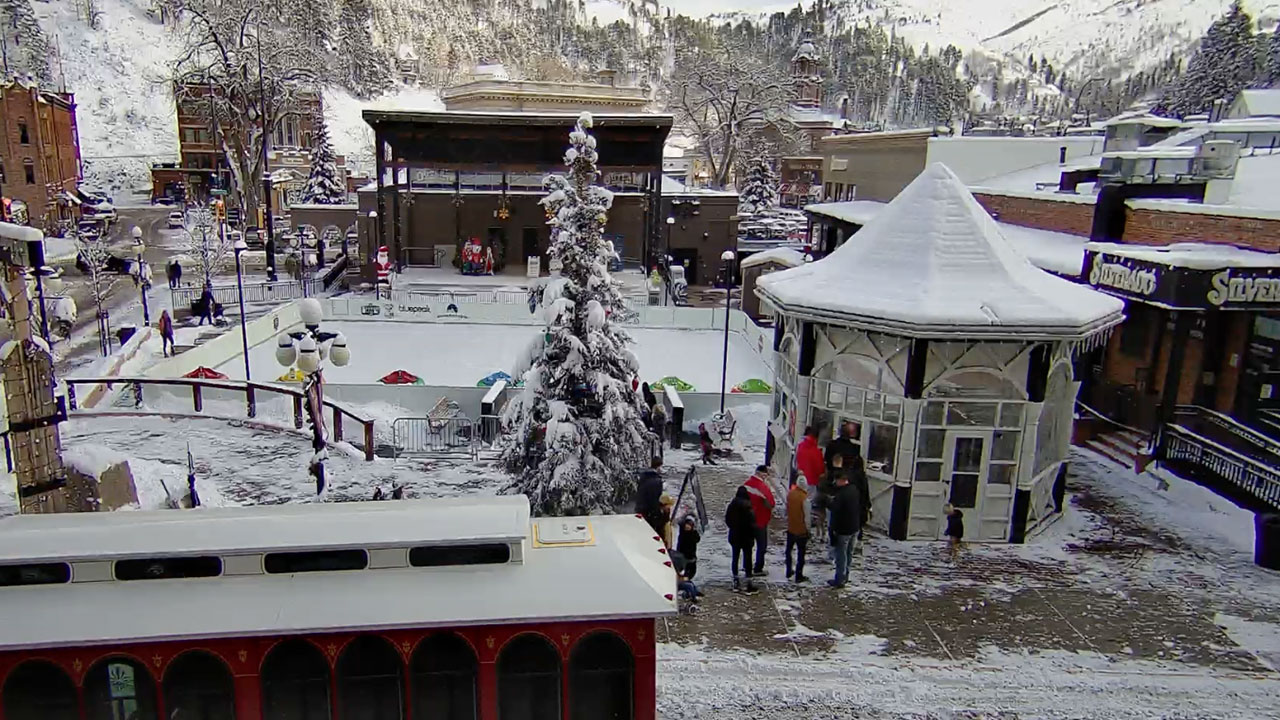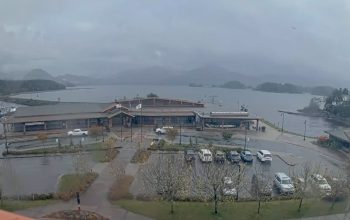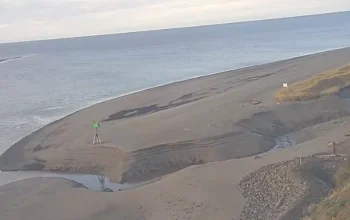Deadwood, South Dakota: Experience the Wild West Live
Deadwood, South Dakota, brings the legendary Wild West to life. Whether you visit in person or tune in through the Deadwood Live Cam, the town’s rich history and vibrant streets are on full display. The live camera streams views of Outlaw Square and Main Street, allowing you to experience the heart of Deadwood from anywhere in the world. It’s the perfect way to catch local events, street performances, and the daily life of this iconic town.
The Sturgis Motorcycle Rally
Each August, the Black Hills of South Dakota roar to life with the thunder of thousands of motorcycles as the Sturgis Motorcycle Rally takes over the region. What began in 1938 as a modest gathering of riders for races and stunts has grown into one of the largest and most iconic motorcycle rallies in the world. While the rally is centered in Sturgis, its reach spreads across the entire region—including Deadwood, just 13 miles away. Deadwood plays a major role in the event, offering entertainment, accommodations, and its own slice of the rally’s wild, colorful culture.
In this article, we’ll explore the rich history of the Sturgis Motorcycle Rally, its deep ties to Deadwood, and the economic, cultural, and public health challenges that come with hosting nearly half a million people in a small, historic town.
The Origins: A Small Event with Big Dreams
The first Sturgis Motorcycle Rally was held in 1938, organized by the Jackpine Gypsies, a motorcycle club based in Sturgis. That year, only a few dozen Indian Motorcycle riders gathered for a day of racing and stunt riding. It was a simple, close-knit affair.
In the years that followed, the rally slowly expanded. After a pause during World War II, it returned in the late 1940s with growing enthusiasm. Riders came from farther and farther away, and each summer, the crowds grew.
By the 1960s and 1970s, the rally was no longer just a local event. It had become a national pilgrimage for motorcycle enthusiasts of all types.
The Sturgis Motorcycle Rally Expansion into Deadwood: A Regional Celebration
As the rally grew, so did its footprint. Soon, the event spread beyond Sturgis to nearby communities. Deadwood, with its historic charm and tourist-friendly vibe, naturally became part of the action.
During the rally, Deadwood transforms into a motorcycle-friendly haven. Its narrow streets, normally echoing with stories of the Wild West, are lined with bikes, vendors, and music stages. The town’s casinos, bars, and hotels fill to capacity. It becomes both a retreat from the larger chaos of Sturgis and a destination in its own right.
Deadwood’s role in the rally includes hosting concerts, bike shows, charity rides, and VIP events. Riders often stay in Deadwood and ride out daily to explore the Black Hills, including famous routes like Spearfish Canyon, Mount Rushmore, and Needles Highway.
Economic Impact of The Sturgis Motorcycle Rally: Fueling the Local Economy
The financial effect of the rally on the region is staggering. According to estimates, the Sturgis Motorcycle Rally generates up to $800 million annually for South Dakota. While Sturgis earns the spotlight, nearby towns like Deadwood benefit significantly.
Hotels, restaurants, gas stations, shops, and bars all see massive spikes in revenue. In fact, during rally week, some businesses earn a third of their annual income. The city of Sturgis itself earns revenue through vendor permits, sponsorships, and official merchandise, totaling hundreds of thousands of dollars each year.
In 2020, the rally accounted for 21% of Sturgis’s annual revenue. While numbers vary year to year, Deadwood also sees an impressive financial boost, especially in the hospitality and entertainment sectors.
Who Attends The Sturgis Motorcycle Rally: A Diverse Crowd on Two Wheels
Contrary to common stereotypes, rally-goers are a diverse mix. You’ll find blue-collar workers, retirees, doctors, CEOs, veterans, artists, and everything in between. Some ride custom choppers; others cruise in on top-of-the-line touring bikes.
What unites them is a love of motorcycles, the freedom of the open road, and the shared experience of riding through the Black Hills. Many return year after year, forging long-lasting friendships and traditions.
Public Safety and Law Enforcement Challenges
With such a large and active crowd, public safety becomes a major concern. During the rally, local law enforcement works overtime to manage traffic, theft, DUI cases, and general crowd control. Roads often turn into parking lots, especially on scenic routes and through downtown Deadwood.
Each year, hundreds of arrests are made, mostly for minor offenses. However, motorcycle theft is also a real problem, with an estimated $250,000 in bikes stolen annually. Sadly, motorcycle fatalities are also common. In 2015, during the 75th anniversary of the rally, 15 fatalities were recorded—the highest on record. In 2023, there were 11 deaths, tying the toll from 1990.
Accidents are often caused by riders failing to navigate turns, alcohol consumption, or riding unfamiliar roads too quickly. The winding roads of the Black Hills, while beautiful, demand careful attention and skill.
Cultural Tensions and Tribal Concerns
One sensitive issue surrounding the rally is its proximity to Bear Butte, a site sacred to the Lakota and other Plains tribes. Each year, tribal leaders express concern about the volume of alcohol and activity near this spiritual place.
At the same time, tribal businesses and members also benefit from the rally’s economic impact. This creates a complex balance between respecting cultural heritage and participating in the regional economy. Some tribal groups have organized peaceful protests or spiritual gatherings during the rally to raise awareness and preserve the sacredness of Bear Butte.
COVID-19 and the 2020 Sturgis Motorcycle Rally: A Health Crisis
The 2020 rally made national headlines—not for its attendance or performances, but for being held during the COVID-19 pandemic. Many public health officials and local leaders wanted to cancel or limit the rally, but that proved nearly impossible. Much of the event takes place outside Sturgis city limits, beyond the reach of city ordinances.
In total, an estimated 462,000 people attended the 2020 rally. Few wore masks, and social distancing was minimal. Within weeks, COVID-19 cases linked to the rally appeared in over 60% of U.S. counties. States such as Minnesota, Nebraska, and Colorado reported dozens of confirmed cases tied to the rally.
Eventually, studies estimated that the rally could have caused up to 267,000 new infections nationwide, with healthcare costs estimated at $12.2 billion. These estimates were later challenged, and some experts questioned their accuracy. However, the CDC confirmed multiple outbreaks stemming from the event, including one COVID-related death in Minnesota.
Despite the controversy, many attendees defended their right to gather, ride, and celebrate. South Dakota Governor Kristi Noem dismissed the studies as flawed, citing freedom of choice and personal responsibility.
The Sturgis Motorcycle Rally Today: Looking Ahead
The Sturgis Motorcycle Rally continues to evolve. Each year brings new safety measures, modernized events, and a push for more inclusive and respectful practices. Deadwood remains a key player, offering a historical yet welcoming backdrop for the rally’s ever-changing landscape.
In recent years, organizers have added COVID testing, more traffic controls, and expanded charity programs. For instance, in 2019, the rally generated over $628,000 for local charities. That same year, more emphasis was placed on rider safety and respect for tribal lands.
Looking forward, the rally faces ongoing questions: How can it grow while staying safe? How should it honor the sacred sites nearby? And how can Deadwood and other towns manage the surge in visitors without losing their unique charm?
The Sturgis Motorcycle Rally is more than just a gathering of bikers. It’s a living tradition, a symbol of freedom, and a complex event with cultural, economic, and public health dimensions. For Deadwood, it’s a major part of the year—bringing energy, revenue, and national attention.
As the rally nears its 100th anniversary, its connection to the Black Hills—and to Deadwood—remains strong. With thoughtful planning and mutual respect, the rally will continue to ride on, roaring through the hills with the spirit of adventure and the echoes of the past.
Things to Do in Deadwood, South Dakota
Step back in time — in all the best ways — in historic Deadwood, South Dakota. Tucked into the scenic Black Hills, this former gold rush town offers a captivating mix of Old West charm and modern-day fun. Deadwood became a National Historic Landmark in 1961, and its streets still carry the spirit of the Wild West. Today, you can stroll along boardwalk-lined streets, take in dramatic mountain views, and enjoy everything from saloon shows to outdoor adventures.
Whether you’re a history buff, thrill-seeker, or just looking for a fun weekend away, Deadwood delivers.
Discover History Around Every Corner
Deadwood’s roots run deep. The town was born during the 1870s gold rush and quickly became a hub for gamblers, gunslingers, and fortune-seekers. Some of its most infamous residents, like Wild Bill Hickok and Calamity Jane, are buried in Mount Moriah Cemetery. A walk through this peaceful spot offers sweeping views of the town and a direct connection to its rugged past.
To dig deeper into Deadwood’s story, head to the Adams Museum and Historic Adams House. These well-preserved spaces tell the story of the town’s boom years, with exhibits ranging from gold nuggets to Victorian antiques. For a unique twist on history, visit The Brothel Deadwood, where you’ll learn about the not-so-secret side of Deadwood’s past.
Feel the Thrill of Live Entertainment
Deadwood isn’t just about the past — it’s alive with action today. Nearly every weekend, the town hosts events that bring locals and visitors together. Catch a live reenactment of a Wild West shootout right on Main Street during the summer. These performances are free and happen daily.
In winter, the action heats up with events like Deadwood Snocross, featuring high-speed snowmobile races. Music fans will love the Deadwood Jam, an annual festival that brings top talent to the hills. And for pure fun, join the crowd during Deadwood’s Mardi Gras, where parades, beads, and music light up the historic downtown.
Try Your Luck at Casinos
Deadwood is one of the few towns in South Dakota where you can legally gamble, and it does not disappoint. Try your luck at places like Cadillac Jack’s Gaming Resort, the largest casino in town. It offers everything from poker tables to slot machines, plus a lively bar and restaurant scene.
Want something more intimate? Visit The Midnight Star, a beautifully restored casino that blends old-school charm with modern gaming. And don’t miss The Landmark Casino, Deadwood’s newest spot featuring sports betting and sleek design.
Savor Local Flavors and Sweet Treats
Start your morning with a pastry and coffee at Lou Lou’s Bombdiggity’s, a quirky cafe full of charm. For lunch or dinner, try a hearty burger or bison steak at Legends Steakhouse, located inside the Historic Franklin Hotel.
And don’t leave town without visiting Chubby Chipmunk Hand-Dipped Chocolates. This beloved candy shop makes rich truffles and chocolate-dipped everything — perfect for gifts or a sweet treat for yourself.
Hike, Bike, and Explore the Outdoors
Beyond its bustling Main Street, Deadwood offers access to incredible outdoor recreation. Mount Roosevelt, just a short drive away, offers a peaceful hike and panoramic views from the Friendship Tower. It’s a great way to stretch your legs and soak in the Black Hills beauty.
If you’re into biking, check out the Mickelson Trail. This scenic, 109-mile trail passes through Deadwood and offers a smooth ride through tunnels, forests, and meadows. You can rent bikes in town and ride as far as you like.
Visit Nearby Attractions
Deadwood makes a great base for exploring the Black Hills. Just down the road is Lead, home to the fascinating Sanford Lab Homestake Visitor Center, which explores the area’s deep mining history.
If you’re up for a day trip, drive to Spearfish Canyon for jaw-dropping waterfalls and winding scenic roads. Or head south to see Mount Rushmore and Crazy Horse Memorial, both within 90 minutes of Deadwood.
Shop, Sip, and Soak in the Atmosphere
Deadwood’s downtown is packed with unique shops. You’ll find everything from vintage western wear to handmade jewelry and local art. For a relaxed afternoon, visit a local tasting room for craft beer or South Dakota-made wine.
In winter, the town transforms into a snowy wonderland. Go ice skating, rent ATVs, or hit nearby ski trails. No matter the season, Deadwood offers endless ways to enjoy the outdoors.
Deadwood, South Dakota, is a town that knows how to blend past and present. With historic charm, thrilling entertainment, and stunning natural beauty, it offers something for every traveler. Whether you’re here for a weekend getaway or an extended adventure, Deadwood invites you to explore, experience, and enjoy.
So lace up your boots, grab a hat, and come see why this little gold rush town still shines.
The Complete History of Deadwood, SD
Deadwood, South Dakota, is one of the most iconic towns in the American West. With roots that reach far deeper than the 19th-century gold rush, its story stretches from the sacred lands of the Lakota to the bustling, lawless gold camps that drew thousands of dreamers and drifters. Deadwood’s journey is one of boom, bust, resilience, and reinvention. It’s a story etched in the landscape of the Black Hills and told through saloons, graveyards, and historic buildings still standing today.
Indigenous Beginnings: The Lakota and the Sacred Black Hills
Long before miners staked their claims in Deadwood Gulch, the Black Hills were home to Native American tribes, including the Lakota Sioux. The Lakota people considered the area sacred—especially the Black Hills, or “Paha Sapa.” These rolling pine-covered hills were central to their spiritual and cultural identity.
The 1868 Treaty of Fort Laramie between the United States and the Lakota guaranteed ownership of the Black Hills to the tribe. It was a promise made on paper, but one the U.S. government soon broke. The sacredness of the land and the treaty violations would remain central to land disputes for generations, many reaching the highest courts in the country.
Gold Changes Everything: Custer’s Expedition and the Black Hills Gold Rush
In 1874, Lieutenant Colonel George Armstrong Custer led a military expedition into the Black Hills. Officially, his mission was to scout for a location for a fort. But in reality, it was also a thinly veiled mission to find gold. On French Creek near what is now Custer, South Dakota, Custer and his men discovered gold. Word spread fast.
Miners, merchants, and adventurers flooded into the area, even though settling the Black Hills violated the 1868 treaty. By early 1876, thousands of prospectors had entered the region illegally. Among them, a group of traders led by Charlie and Steve Utter arrived with a wagon train full of goods—and a few women, including the famous Madame Mustache and Dirty Em, who quickly found business in the male-dominated camps.
Deadwood emerged almost overnight. It was illegal, unorganized, and unsanctioned, but it was booming.
Deadwood’s Rise: A Town of Fortune and Lawlessness
By mid-1876, Deadwood had grown into a bustling town of more than 5,000 people, and some estimates say the population soared to 25,000. With no formal law enforcement, Deadwood was a rough place. Gambling, drinking, and prostitution were open and thriving. Murder and theft were common.
Women were in high demand, and prostitution proved to be a profitable business. Madam Dora DuFran and Madam Mollie Johnson became two of the town’s most successful brothel owners. The now-notorious Gem Variety Theater, opened by Al Swearengen in 1877, became a hub of entertainment and vice.
The town’s most infamous moment came on August 2, 1876, when Wild Bill Hickok was shot in the back while playing poker at Nuttal & Mann’s Saloon. He was holding what’s now known as the “dead man’s hand”—a pair of aces and eights. His killer, Jack McCall, was initially acquitted in a local trial but later convicted and hanged after being retried in a court with legal authority.
Epidemics, Fires, and Struggles
Deadwood’s growth came with challenges. In August 1876, a smallpox epidemic swept through the camp. With no hospitals, tents were used to quarantine the sick. Many died. The town was also hit by a devastating fire in September 1879, which destroyed more than 300 buildings. Though Deadwood rebuilt, many left for good.
Still, Deadwood pressed on. In 1877, the Homestake Mine began operations in nearby Lead. It became the most productive gold mine in the United States and operated until 2002. The mine’s success helped stabilize the region’s economy, shifting Deadwood from panning camps to a more structured mining town.
Electrifying Progress and Railroad Expansion
Despite its remote location, Deadwood became a pioneer in electrical service. In 1883, Judge Squire P. Romans started the Pilcher Electric Light Company and brought electricity to the town less than four years after Thomas Edison’s first commercial light system in New Jersey. Deadwood lit up, both literally and figuratively.
In 1888, the Deadwood Central Railroad was founded to serve local mining operations. Eventually bought by the Chicago, Burlington and Quincy Railroad, parts of the railway were electrified for passenger use between Deadwood and Lead. However, the rail lines were eventually abandoned in the 20th century.
Deadwood’s Diverse Population: The Chinese Quarter and More
Deadwood wasn’t only home to miners and cowboys. A vibrant Chinatown developed in the late 1800s, with over 250 Chinese residents at its peak. Most worked in service roles, running laundries, restaurants, and shops. Wong Fee Lee, a prominent merchant, emerged as a leader in the Chinese community and remained a respected figure until his death in 1921.
The town was also home to African American residents, European immigrants, and other diverse groups. In recent years, archaeologists have excavated parts of Deadwood’s Chinatown, uncovering artifacts and stories from this often-overlooked chapter of the town’s history.
20th Century Decline and Disaster
The 1900s were less kind to Deadwood. Gold production slowed. Fires continued to be a threat, including a major one in 1959 that burned thousands of acres and caused a large evacuation. The once-bustling town dwindled in population and influence.
In 1961, Deadwood was declared a National Historic Landmark, preserving its buildings and history. Still, the economy struggled, especially after Interstate 90 bypassed the town in 1964.
One of the town’s most colorful legacies came to an end on May 21, 1980, when law enforcement raided the last three operating brothels in town: “The White Door,” “Pam’s Purple Door,” and “Dixie’s Green Door.” That ended over a century of tolerated prostitution in Deadwood.
Revival Through Gambling and Tourism
In 1987, fire destroyed the historic Syndicate Building, sparking a push to revitalize the town. City leaders launched the “Deadwood Experiment”, hoping to restore the town’s economy through legal gambling. At the time, only Nevada and Atlantic City allowed gaming.
In 1989, Deadwood became the first small town in the U.S. to legalize gambling. Slot machines and card tables returned—not in dusty saloons but in newly refurbished casinos. Tourism exploded, and with it came new jobs, hotels, and investment. The move helped fund historic preservation, blending modern entertainment with 19th-century charm.
Deadwood Today: A Living Legacy
Today, Deadwood is both a tourist destination and a historical monument. Visitors walk the same streets as Wild Bill Hickok and Calamity Jane. They visit Mount Moriah Cemetery, gamble in restored casinos, and explore museums that capture the full sweep of Deadwood’s colorful past.
Heritage tourism now drives the local economy. Preservation efforts continue, even as the town balances the demands of development. The story of Deadwood isn’t just about gold or gunfights. It’s about survival, identity, and transformation. From sacred Lakota land to a lawless gold camp to a modern tourist haven, Deadwood’s history reflects the larger American story—with all its promise, conflict, and reinvention.
The Climate of Deadwood, South Dakota
Deadwood, South Dakota, nestled in the northern Black Hills, experiences a climate unlike much of the surrounding Great Plains. While most areas of South Dakota are relatively dry, Deadwood sees more precipitation, heavier snowfall, and milder summer temperatures, all due to its elevation and mountainous surroundings. Weather in Deadwood can shift quickly, and the seasons often come with dramatic changes.
A Wetter Spot in a Dry State
Most of South Dakota averages less than 25 inches of precipitation each year. In contrast, the Lead-Deadwood area receives nearly 30 inches annually. That extra moisture makes Deadwood one of the wetter spots in the state. Storm systems that pass over the Black Hills often drop more rain and snow here than in lower, flatter areas nearby.
Because of this, Deadwood often looks greener in spring and summer than other parts of the state. But that added moisture also means more snow in winter—a lot more.
Heavy Snowfall Balanced by Chinooks
Deadwood sees a mean annual snowfall of over 100 inches, which is more than 8 feet each year. However, despite these heavy snowfalls, snow rarely sticks around for long. This is thanks to warm, dry Chinook winds that sweep through the area, often melting snow quickly—even in mid-winter.
Even in January, when temperatures are typically coldest, the median snow depth is often zero. Snow does build up after major storms, though. For instance, on November 6, 2008, a storm dumped nearly 46 inches of snow on the area. That left 35 inches of snow on the ground—a clear example of how fast winter can take over in Deadwood.
Spring: Short, Stormy, and Full of Surprises
Spring in Deadwood tends to be brief and dramatic. March and April often bring heavy, wet snowstorms mixed with rain. Sudden temperature changes are common. April, in particular, can be wild. For example, in April 2006, a single storm brought 54 inches of snow, leaving a record 39-inch snow depth on April 19.
Despite these snowstorms, spring also marks the return of warmer days. The first 70°F day usually arrives in early April. By May, temperatures can hit the 80s, and 90°F is often reached by mid-June. Still, overnight lows stay cool for much longer. In fact, freezing temperatures can still occur well into May.
Summer: Warm Days, Cool Nights
Summers in Deadwood are generally warm but not extreme. The town only sees around 15 days a year where temperatures hit or exceed 90°F. Compared to the scorching summers elsewhere in the Midwest, Deadwood’s summer climate feels fairly mild. That’s largely due to its higher elevation.
Even during the warmest days, nights are cool. This makes summer a popular time for tourists looking to escape hotter climates. Rainfall drops off in the summer, with July and August typically drier than the spring months. In rare cases, summer can be extremely dry—like in August 2000, when not even a trace of rain fell.
Fall: Sunny, Crisp, and Changeable
Autumn in Deadwood is often sunny and dry, with pleasant daytime temperatures and crisp nights. However, weather patterns become more unpredictable. One day may feel like summer, and the next may hint at winter. Rain is less frequent, but early snowfalls can begin in October.
The fall months are beautiful in the Black Hills. The cooler temperatures, dry air, and changing leaves create a striking landscape. It’s a quieter season, perfect for hiking, sightseeing, and enjoying the outdoors before the heavy snows return.
A Climate of Contrasts
Deadwood’s climate is marked by contrasts. Winters are snowy, yet often mild due to Chinooks. Springs are stormy and short. Summers are warm but rarely hot. Falls are sunny and unpredictable. While these patterns can make travel or planning tricky, they also add to the town’s character.
This unique weather pattern has shaped Deadwood’s history, economy, and even its buildings. From the hardy miners who braved heavy snowstorms in the 1800s to today’s tourists enjoying mild summer evenings, the climate remains a defining feature of this historic mountain town.



